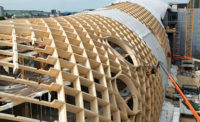Earlier this fall, the American Society of Landscape Architects (ASLA) released performance data for the green roof planted on its Washington, D.C., headquarters. The findings demonstrate a number of environmental benefits, including a significant reduction in storm-water runoff, retaining 27,500 gallons of water, or nearly 75 percent of precipitation, during a 10-month monitoring period.

The results suggest that widespread implementation of green roofs and other sustainable site development practices could be a viable storm-water-management option, particularly in cities with older, and overburdened, combined sanitary and wastewater transportation systems. “Collectively, green roofs could save billions of dollars in urban infrastructure costs,” says Nancy Somerville, the society’s C.E.O.
The ASLA installed the roof in spring 2006 in lieu of replacing its deteriorating 3,000-square-foot conventional roof. The retrofit, designed by New York City–based Michael Van Valkenburgh Associates, includes planted berms that camouflage mechanical units and an extensive green roof system protected by metal grating at circulation areas.
In addition to measuring runoff, researchers also monitored water quality, comparing it to that of rainwater. Surprisingly, the installation’s effectiveness in reducing runoff hindered collection of testing samples. “There were many instances when there was no effluent,” says Charles Glass, associate professor of civil engineering at Howard University. Glass and environmental consultant ETEC conducted the water-quality and -quantity monitoring.
The runoff that investigators did collect contained some contaminants considered harmful to natural water bodies, but within concentrations allowed by the the U.S. Environmental Protection Agency. The ASLA expects the quality of the runoff to improve over time. “Young green roofs leech nutrients,” says Somerville. The organization plans to repeat the quality tests in two years and compare the runoff with that from a conventional roof.
The monitoring effort also revealed a potential for saving energy and mitigating the urban-heat-island effect. The installation lowered summer air temperatures by as much as 32 degrees when compared with a nearby standard roof. Although winter energy use dropped by 10 percent, cooling-season reductions were not demonstrated due to an oversize air-conditioning system, says Somerville. After making mechanical system adjustments, the ASLA expects to realize savings next summer.





